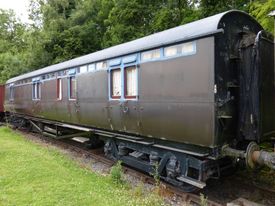GWR 261 Toplight 'Snake C' Passenger Brake
| GWR 261 Toplight 'Snake C' Passenger Brake | |
|---|---|
 GWR toplight 'Snake C' Passenger Brake 261 (July 2015) | |
| Built By | GWR Swindon |
| Status | Static use |
| Number | 261 |
| Other numbers | W261, W261W |
| History | |
| Built | 1922 |
| Designed By | Churchward |
| Diagram | K22 |
| Lot | 1281 |
| Type | Snake C, BG |
| Length | 56ft 11¼in |
| Seats | None |
| 1982 | Entered preservation |
| 1996 | Arrived on SVR |
GWR 261 is a Churchward 'Toplight' Gangwayed Passenger Brake (BG). This type of 'full brake', which was given the GWR telegraphic code "SNAKE C", contained no passenger seating and was therefore classed as Non Passenger Carrying Coaching Stock (NPCCS). The internal layout consisted of a guard's compartment situated between two luggage compartments, the larger of which occupied more than half the length of the coach. A corridor along one side allowed passengers to pass through.
GWR 261 was designed by the GWR's Locomotive, Carriage and Wagon Superintendent George Jackson Churchward and built to Diagram K22. The first two carriages to that Diagram were built in 1915, with a further 36 built in 1921 and 1922,[1] the last ones being completed after Churchward retirement.[note 1] The Diagram 22 carriages held the distinction of being both the last 'Toplights' to be built at Swindon and the last such carriages in BR use, continuing in service until 1961-62.[2]
Sister carriage 1145 of 1922 is also preserved on the SVR and can be seen at Bewdley, where it serves as The Great Western (SVR) Association Shop. 261 and 1145 were the subject of an article by Chris Haynes in the Great Western (SVR) Association Newsletter, Summer 2022, the title "Churchward Passenger Brake Van Centenarians" denoting that both are now more than 100 years old.
A third 'SNAKE C', GWR 1150, was also based at Bewdley between 1981 and 2001 where it was home to the "Wribbenhall Junction" model railway layout.
Contents
Service and preservation
261 was built at Swindon in 1921 as part of Lot 1281, being outshopped in September of that year.[note 2] It continued in use with BR(W), renumbered W261W, until April 1961.[1] After withdrawal from service, it was sold to Llanwern Steelworks for internal use as a mess van.[3]
261 was acquired for preservation at the Pontypool and Blaenavon Railway in 1982 by Mark Vrettos[2] for potential use as a catering vehicle. Some restoration work was carried out there, but was still incomplete when 261 was purchased by Great Western (SVR) Association member Mike Walker. This enabled a transfer to the Severn Valley Railway to take place on 20 March 1996, where completion of the restoration could take place.[3]
The 1999 SVR Stock Book included a picture of 261 at Kidderminster, noting that "It is intended to keep it in full running order".[3] However by 2000 it was positioned at Highley, adjacent to the Highley signal box,[4]. As of 2022[update] it was still at Highley, where it has been used since arrival for storage and as temporary overnight accommodation, and still owned by Mike Walker. Sadly, he died on 14 January 2023.
Gallery
In the picture from July 2015 (top right), 261 is in similar condition to the undated illustration in Chris Haynes' article, which is captioned "261 at Highley after its main restoration". For comparison, two other pictures from before and after that date are shown below; the blue primer around the windows is not visible in either.
As seen from left to right, the first two sets of double doors gave access to the larger luggage compartment, the single door was for the guard's compartment, and the final pair of double doors gave access to the smaller luggage compartment.
See also
Notes
- ↑ The title of 'Locomotive, Carriage and Wagon Superintendent' ended with Churchward's retirement, his successor C.B. Collett adopting the more familiar title 'Chief Mechanical Engineer' (CME).
- ↑ Lot 1281 comprised running numbers 257 to 266, although they were not completed sequentially. 261 and 265 were outshopped in September 1921, the others were completed between October 1921 and April 1922.
References
Links
| ||||||||||||||||||||||||||||||

